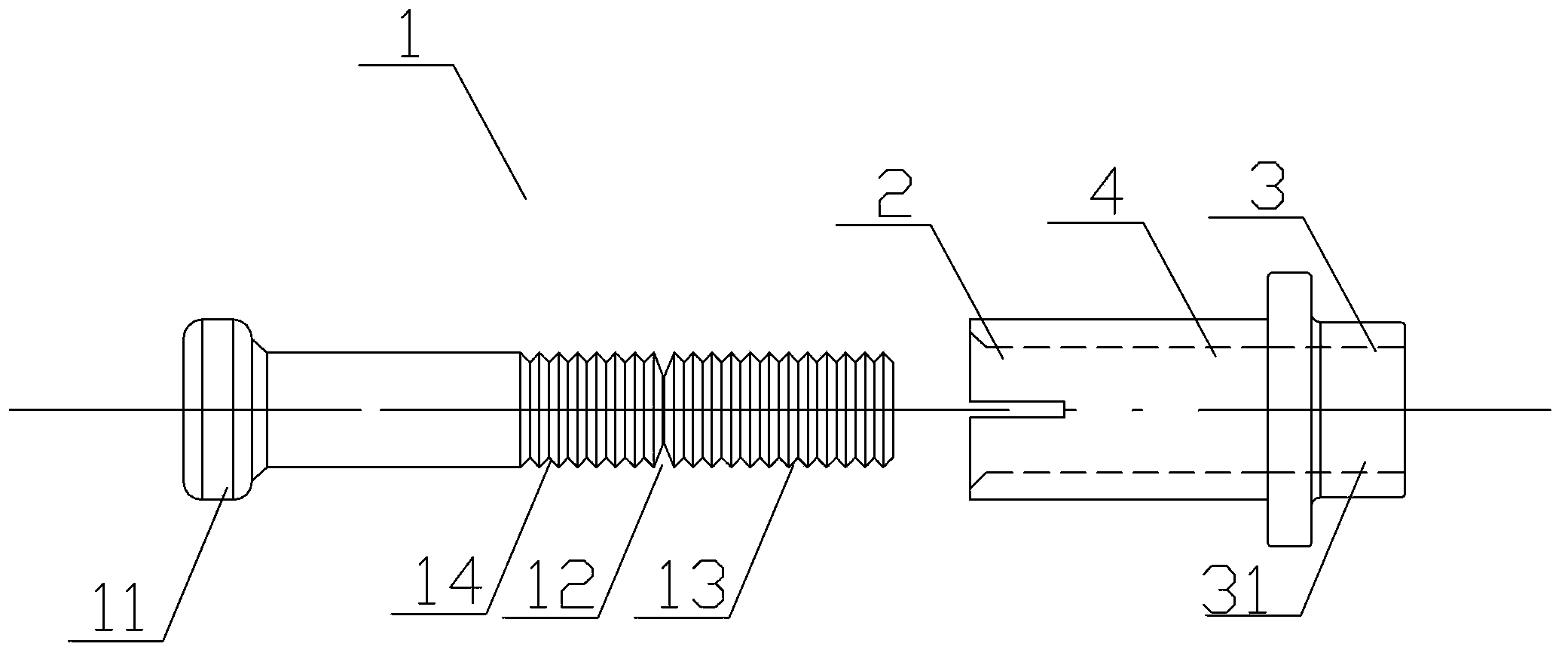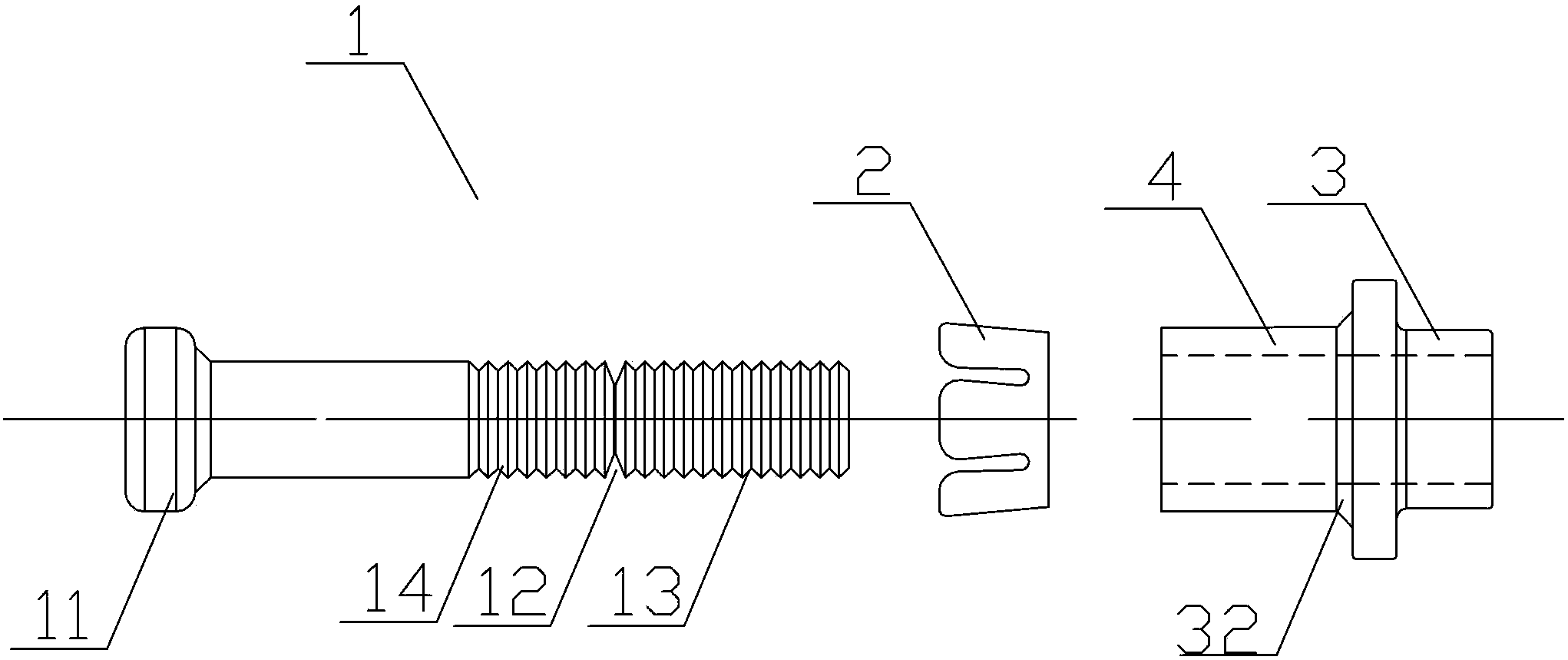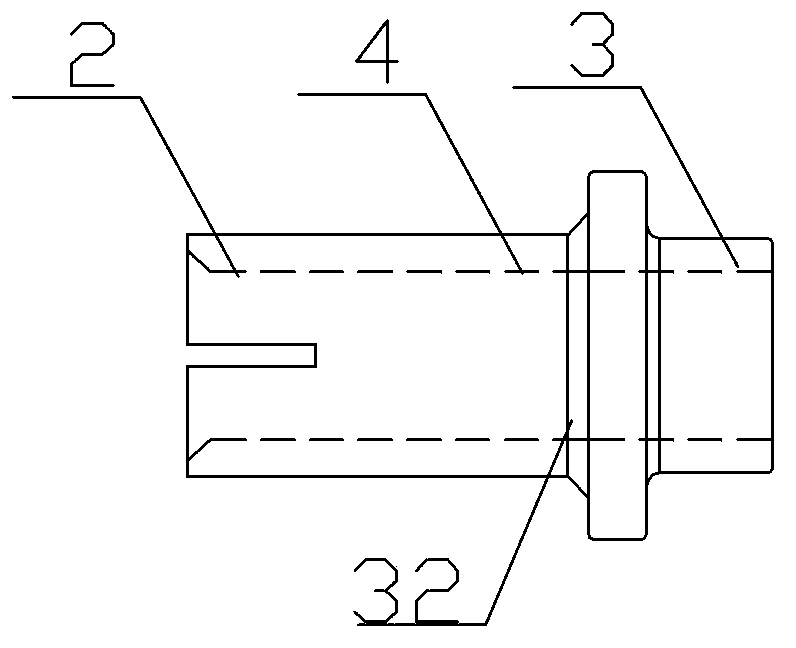Drifting-proof blind rivet bolt and connecting structure
A technology of blind riveting and displacement, applied in the direction of building components, building structures, walls, etc., can solve the problems of sagging connection holes, safety hazards of de-soldering, loose anchors, etc., to increase the connection strength, meet the seismic requirements, The effect of reliable connection and positioning
- Summary
- Abstract
- Description
- Claims
- Application Information
AI Technical Summary
Problems solved by technology
Method used
Image
Examples
Embodiment 1
[0035] Embodiment 1, with reference to attached figure 1
[0036] An anti-displacement blind rivet bolt provided by the present invention includes a metal rivet rod 1, an anti-lock expansion part 2, and a casing 4. The inner end of the metal rivet rod is provided with a protruding head 11 that expands the anti-lock expansion part 2, and the metal rivet rod The outer side of 1 has a connecting section 13 for connecting with tools, and the metal rivet rod 1 passes through the anti-lock expansion part 2; the blind rivet bolt is also provided with a fastening sleeve 3, and the fastening sleeve 3 is correspondingly located On the outside of the connecting piece 100, the connected piece can be a plate, and the metal rivet rod 1 has an anti-loose riveting segment 14 corresponding to the fastening sleeve 3, and the anti-loosening riveting segment 14 is formed with an anti-loosening Lines, such as concave lines, embossed lines, rings, annular grooves, etc., make the surface of the...
Embodiment 2
[0042] Embodiment 2, with reference to attached figure 2 .
[0043] In addition to the embodiment of the embodiment 1, the anti-lock expansion member 2 can also be a single ring-shaped element like this embodiment, and the plurality of expansion pieces are arranged along the circumferential direction of the ring. The sleeve 4 is integrated with the fastening sleeve 3 .
[0044] Further, the front end of the tightening sleeve has a bead or protrusion 32, and the bead or protrusion 32 is used to squeeze the connected part tightly when the tightening sleeve 3 is pressed by the tool. , is squeezed into the gap between the hole wall of the hole through which the sleeve 4 passes through the connected piece and the sleeve 4, forming a squeeze or interference fit, and plays a positioning role for the connected piece to prevent slippage, further Keep it from sagging or loose up and down.
[0045] The collar or protrusion at the front end of the fastening sleeve can also have tooth ...
Embodiment 3
[0047] Embodiment 3, with reference to image 3 .
[0048] In this embodiment, the implementation of the anti-locking expansion member 2 , the sleeve 4 and the fastening sleeve 3 will be described emphatically.
[0049] In this embodiment, the relationship among the anti-lock expansion member 2 , the sleeve 4 and the fastening sleeve 3 adopts the method of the first embodiment. In addition, there is a protruding ring 32 at the front end of the tightening sleeve 3, and the protruding ring or protrusion 32 is used for being pressed when the tightening sleeve 3 is pressed tightly by the tool to tighten the connected part. Squeeze into the gap between the hole wall of the hole through which the sleeve 4 passes through the connected part and the sleeve 4 to form a squeeze or interference fit, and play a positioning role to prevent slipping of the connected part, further preventing its Saggy or loose up and down.
PUM
 Login to View More
Login to View More Abstract
Description
Claims
Application Information
 Login to View More
Login to View More - R&D
- Intellectual Property
- Life Sciences
- Materials
- Tech Scout
- Unparalleled Data Quality
- Higher Quality Content
- 60% Fewer Hallucinations
Browse by: Latest US Patents, China's latest patents, Technical Efficacy Thesaurus, Application Domain, Technology Topic, Popular Technical Reports.
© 2025 PatSnap. All rights reserved.Legal|Privacy policy|Modern Slavery Act Transparency Statement|Sitemap|About US| Contact US: help@patsnap.com



